Development of a Flexible Lead-Free Piezoelectric Transducer for Health Monitoring in the Space Environment
Abstract
:1. Introduction
| Properties | Symbol | Unit | Material | PVDF β Phase * | P(VDF-TrFE) β Phase * | |||
|---|---|---|---|---|---|---|---|---|
| PZT | ZnO | BaTiO3 | AlN | |||||
| Cost | P | €/g | 15.2 | 5.9 | 15.4 | 15.2 | 1–2 | 7 |
| Toxicity | LD | mg/kg | – | No | – | – | – | – |
| Reusable in laboratory | – | – | Yes | Yes | Yes | Yes | Yes | Yes |
| Reproducible in laboratory | – | – | Yes | Yes | Yes | Yes | Yes | Yes |
| Conformable | – | – | Yes | Yes | Yes | Yes | Yes | Yes |
| Metallization on both sides | – | – | Yes | Yes | Yes | Yes | Yes | Yes |
| Actuator/sensor function | – | – | Yes | Yes | Yes | Yes | Yes | Yes |
| Adhesion to metal and CFRP substrate | – | – | Yes | Yes | Yes | Yes | Yes | Yes |
| PE coefficient | d33 | pm/V | 280–380 | 12 | 140–250 | 4.5–6.4 | 13–22 | −20 |
| d31 | pm/V | −123 | −5 | −30 | −3.2 | 6–10 | 6 | |
| Curie temperature | TC | °C | 300 | N/A | 120 | >2000 | N/A | 112 |
| relative permittivity | εr | – | >300 | 8.3 | 190–700 | 9.5–10.5 | 10–12 | 8–12 |
| Density | ρ | g/cm3 | 7.5 | 5.6 | 5.9 | 3.3 | 1.8 | 3 |
| Tangent loss angle | tan δ | – | 0.08–0.06 | 0.053 | 0.012–0.015 | 0.02–0.06 | 0.010–0.035 | 0.016 |
| Young modulus | E | GPa | 60–70 | 80–140 | 67–200 | 300–350 | 2–3.4 | 1 |
2. Experimental Section
| Target | RF Power Density (W∙cm−2) | Gas Pressure (bar) | Ar Flow (sccm) | O2 Flow (sccm) | Thickness (nm) |
|---|---|---|---|---|---|
| Au | 4.9 | 4 × 10−6 | 20 | – | 100 |
| ZnO | 1.8 | 4 × 10−6 | 19 | 1 | 700 |
3. Results and Discussion
3.1. Gold Electrodes—Preparation and Characterization

3.2. ZnO Thin Films—Preparation and Characterization
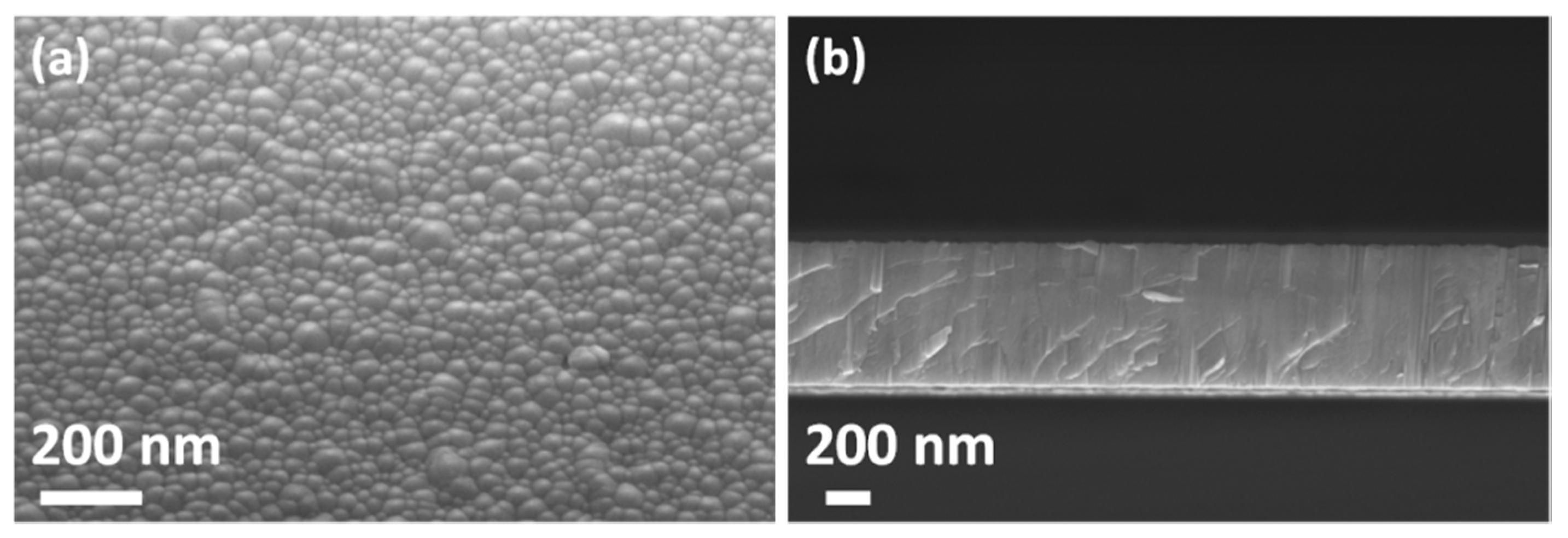
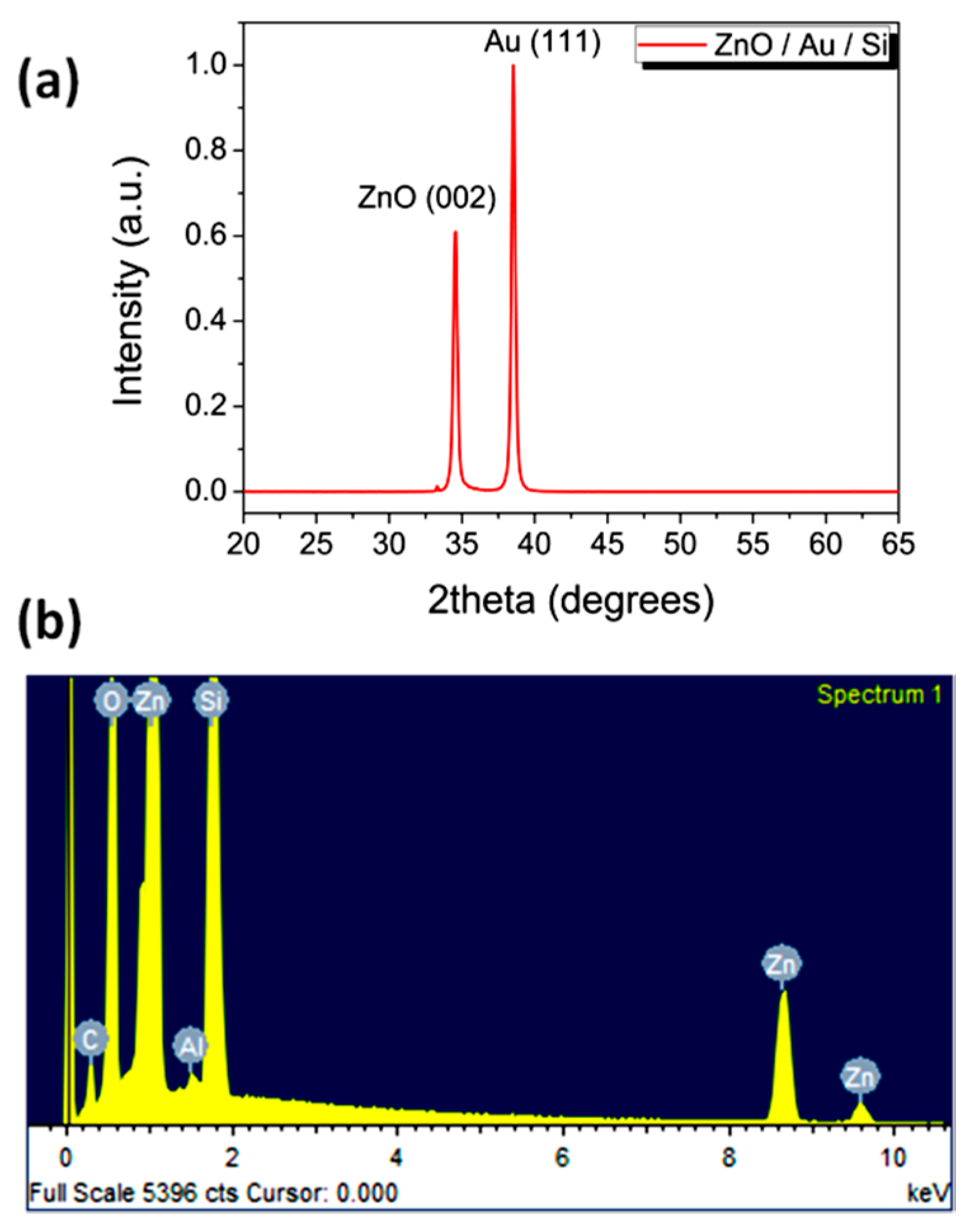
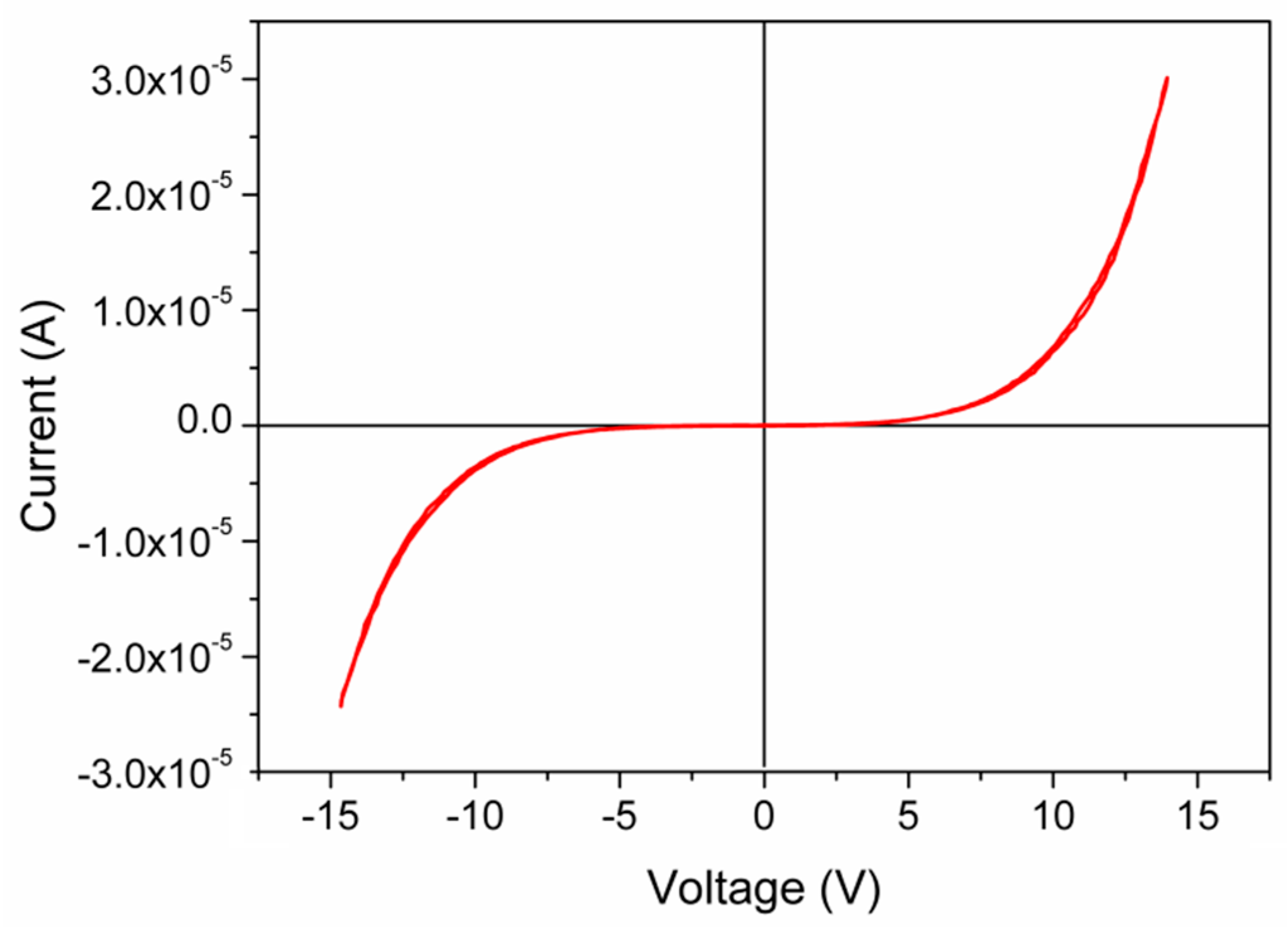
3.3. Device Fabrication and Characterization
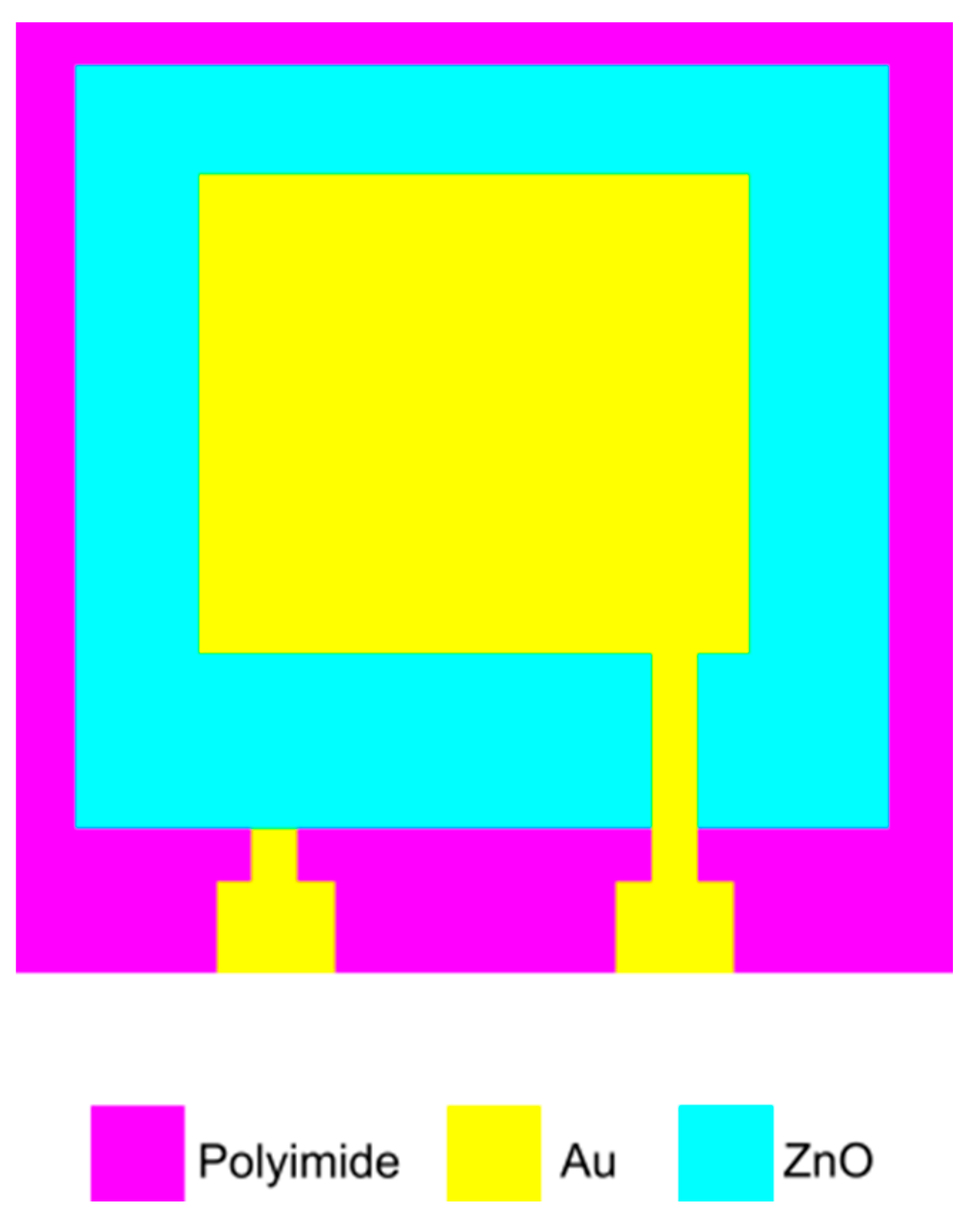
- Lower and upper Polyimide supports (total patch dimensions: 10 mm × 10 mm);
- 100 nm-thick Au bottom electrode (5 mm × 5 mm);
- 700 nm-thick ZnO piezoceramic layer (8 mm × 8 mm);
- 100 nm-thick Au top electrode (4 mm × 4 mm).
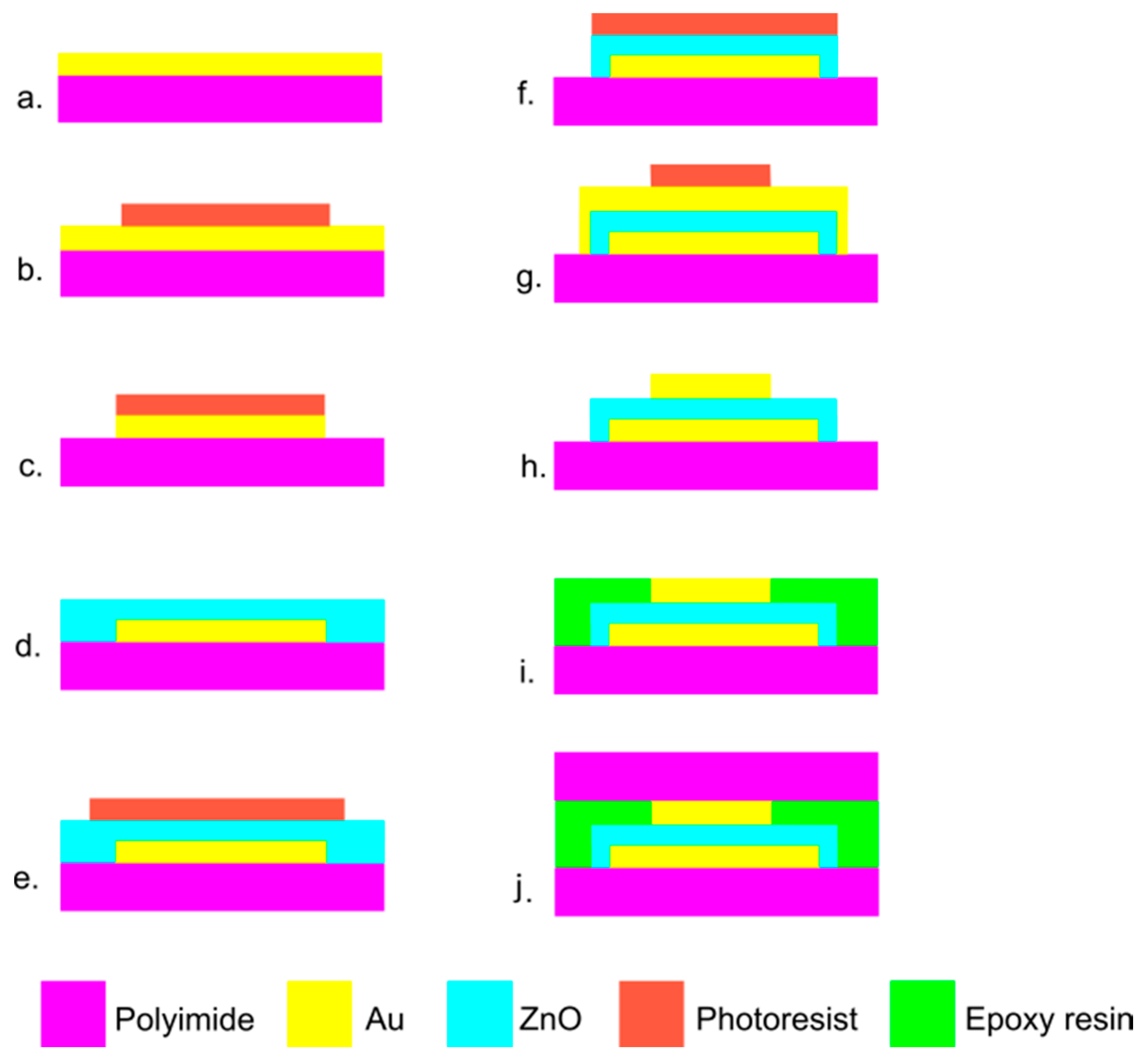
| Parameter | Value |
|---|---|
| Active Area | 4 mm × 4 mm |
| Active layer thickness | 900 nm |
| Minimum curvature radius | 6 mm |
| Operating temperature | −40 °C up to 80 °C |
| Breakdown voltage * | ±40 V |
| d33 | 12.3 pm/V |
| Typical operating voltage | ±15 V |
| Typical operating frequency | 100 Hz |
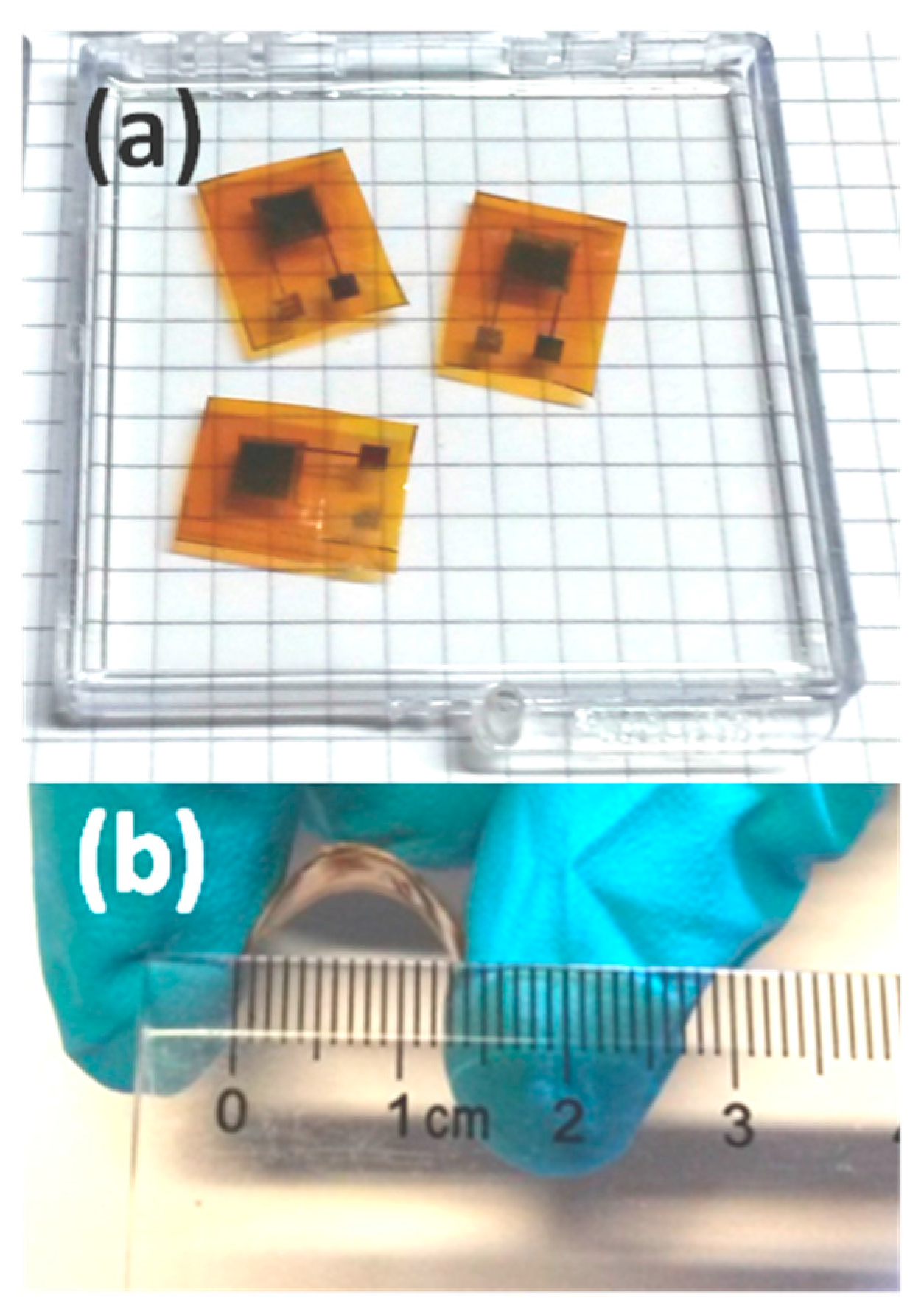
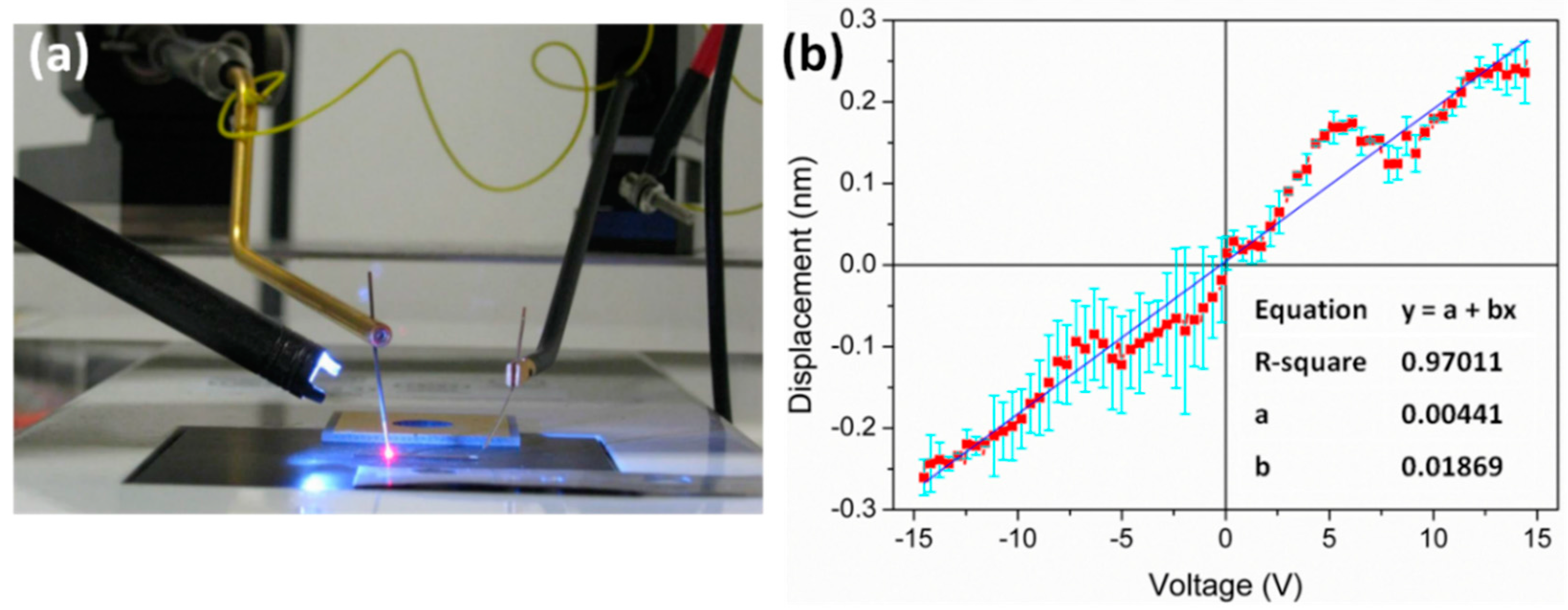
4. Conclusions
Acknowledgments
Author Contributions
Conflicts of Interest
References
- Dodds, J.S.; Meyers, F.N.; Loh, K.J. Piezoelectric nanocomposite sensors assembled using zinc oxide nanoparticles and poly(vinylidene fluoride). Smart Struct. Syst. 2013, 12, 055–071. [Google Scholar] [CrossRef]
- Yoon, H.S.; Jung, D.; Kim, J.H. Lamb wave generation and detection using piezoceramic stack transducers for structural health monitoring applications. Smart Mater. Struct. 2012, 21, 055019. [Google Scholar] [CrossRef]
- Joshi, S.; Hegde, G.M.; Nayak, M.M.; Rajanna, K. A novel piezoelectric thin film impact sensor: Application in non-destructive material discrimination. Sens. Actuators A 2013, 199, 272–282. [Google Scholar] [CrossRef]
- Yan, S.; Wu, J.; Sun, W.; Ma, H.; Yan, H. Development and application of structural health monitoring system based on piezoelectric sensors. Int. J. Distrib. Sens. Netw. 2013, 270927, 12. [Google Scholar] [CrossRef]
- Ko, J.M.; Ni, Y.Q. Technology developments in structural health monitoring of large-scale bridges. Eng. Struct. 2005, 27, 1715–1725. [Google Scholar] [CrossRef]
- Lu, Y.; Wang, X.; Tang, J.; Ding, Y. Damage detection using piezoelectric transducers and the Lamb wave approach: II. Robust and quantitative decision making. Smart Mater. Struct. 2008, 17, 025034. [Google Scholar] [CrossRef] [Green Version]
- Betz, D.C.; Thursby, G.; Culshaw, B.; Staszewski, W.J. Structural damage location with fiber bragg grating rosettes and lamb waves. Struct. Health Monit. 2007, 6, 299–308. [Google Scholar] [CrossRef]
- Barazanchy, D.; Martinez, M.; Rocha, B.; Yanishevsky, M. A hybrid structural health monitoring system for the detection and localization of damage in composite structures. J. Sens. 2014, 109403. [Google Scholar] [CrossRef]
- Chiolerio, A.; Roppolo, I.; Sangermano, M. Radical diffusion engineering: Tailored nanocomposite materials for piezoresistive inkjet printed strain measurement. RSC Adv. 2013, 3, 3446–3452. [Google Scholar] [CrossRef]
- Giorgio, I.; Galantucci, L.; Della Corte, A.; del Vescovo, D. Piezo-electromechanical smart materials with distributed arrays of piezoelectric transducers: Current and upcoming applications. Int. J. Appl. Electromagn. Mech. 2015, 47, 1051–1084. [Google Scholar] [CrossRef]
- Dell’Isola, F.; Vestroni, F.; Vidoli, S. Structural-damage detection by distributed piezoelectric transducers and tuned electric circuits. Res. Nondestruct. Eval. 2005, 16, 101–118. [Google Scholar] [CrossRef]
- Dell’Isola, F.; Vestroni, F.; Vidoli, S. A class of electro-mechanical systems: Linear and nonlinear dynamics. J. Theor. Appl. Mech. 2002, 40, 47–71. [Google Scholar]
- Su, Z.; Ye, L.; Ye, L. Guided lamb waves for identification of damage in composite structures: A review. J. Sound Vib. 2006, 295, 753–780. [Google Scholar] [CrossRef]
- Giurgiutiu, V.; Zagrai, A. Damage detection in thin plates and aerospace structures with the electro-mechanical impedance method. Struct. Health Monit. 2005, 4, 99–118. [Google Scholar] [CrossRef]
- Ciang, C.C.; Lee, J.R.; Bang, H.J. Structural health monitoring for a wind turbine system: A review of damage detection methods. Meas. Sci. Technol. 2008, 19, 122001. [Google Scholar] [CrossRef]
- Daré de Almeida, V.A.; Guimarães Baptista, F.; de Aguiar, P.R. Piezoelectric transducers assessed by the pencil lead break for impedance-based structural health monitoring. IEEE Sens. J. 2015, 15, 693–702. (In Portuguese) [Google Scholar] [CrossRef]
- Gary, J.; Hamstad, M.A. On the far-field structure of waves generated by a pencil lead break on a thin plate. J. Acoust. Emiss. 1994, 12, 157–170. [Google Scholar]
- Sohn, H.; Park, G.; Wait, J.R.; Limback, N.P.; Farrar, C.R. Wavelet-based active sensing for delamination detection in composite structure. Smart Mater. Struct. 2004, 13, 153–160. [Google Scholar] [CrossRef]
- Wang, C.S.; Wu, F.; Chang, F.K. Structural health monitoring from fiber-reinforced composites to steel-reinforced concrete. Smart Mater. Struct. 2001, 10, 548. [Google Scholar] [CrossRef]
- Park, S.; Yun, C.B.; Roh, Y.; Lee, J.J. PZT-based active damage detection techniques for steel bridge components. Smart Mater. Struct. 2006, 15, 957. [Google Scholar] [CrossRef]
- Law, C.W.; Tong, K.Y.; Li, J.H.; Li, K. Effect of pyrolysis temperature on the characteristics of PZT films deposited by the sol-gel method. Thin Solid Films 1998, 335, 220–224. [Google Scholar] [CrossRef]
- Chiolerio, A.; Quaglio, M.; Lamberti, A.; Celegato, F.; Balma, D.; Allia, P. Magnetoelastic coupling in multilayered ferroelectric/ferromagnetic thin films: A quantitative evaluation. Appl. Surface Sci. 2012, 258, 8072–8077. [Google Scholar] [CrossRef]
- Makino, H.; Kamiya, N. Effects of DC electric fields on mechanical properties of piezoelectric ceramics. Jpn. J. Appl. Phys. 1994, 33, 5323–5327. [Google Scholar] [CrossRef]
- Watanabe, S.; Fujiu, T.; Fujii, T. Effect of poling on piezoelectric properties of lead zirconate titanate thin films formed by sputtering. Appl. Phys. Lett. 1995, 66, 1481–1483. [Google Scholar] [CrossRef]
- Lin, B.; Giurgiutiu, V. Modeling and testing of PZT and PVDF piezoelectric wafer active sensors. Smart Mater. Struct. 2006, 15, 1085–1093. [Google Scholar] [CrossRef]
- Monkhouse, R.; Wilcox, P.; Cawley, P. Flexible interdigital PVDF transducers for the generation of Lamb waves in structures. Ultrasonics 1997, 35, 489–498. [Google Scholar] [CrossRef]
- Furukawa, T.; Ishida, K.; Fukada, E. Piezoelectric properties in the composite systems of polymers and PZT ceramics. J. Appl. Phys. 1979, 50, 4904–4912. [Google Scholar] [CrossRef]
- Venkatragavaraj, E.; Satish, B.; Vinod, P.R.; Vijaya, M.S. Piezoelectric properties of ferroelectric PZT-polymer composites. J. Phys. D: Applied Physics 2001, 34, 487. [Google Scholar] [CrossRef]
- Dietze, M.; Es-Souni, M. Structural and functional properties of screen-printed PZT–PVDF-TrFE composites. Sens. Actuators A Phys. 2008, 143, 329–334. [Google Scholar] [CrossRef]
- Panda, P.K. Review: Environmental friendly lead-free piezoelectric materials. J. Mater. Sci. 2009, 44, 5049–5062. [Google Scholar] [CrossRef]
- Park, K.I.; Xu, S.; Liu, Y.; Hwang, G.T.; Kang, S.J.L.; Wang, Z.L.; Lee, K.J. Piezoelectric BaTiO3 thin film nanogenerator on plastic substrates. Nano Lett. 2010, 10, 4939–4943. [Google Scholar] [CrossRef] [PubMed]
- Chiolerio, A.; Lombardi, M.; Guerriero, A.; Canavese, G.; Stassi, S.; Gazia, R.; Cauda, V.; Manfredi, D.; Chiodoni, A.; Verna, A.; et al. Effect of the fabrication method on the functional properties of BaTiO3: PVDF nanocomposites. J. Mater. Sci. 2013, 48, 6943–6951. [Google Scholar] [CrossRef]
- Iriarte, G.F.; Rodriguez, J.G.; Calle, F. Synthesis of c-axis oriented AlN thin films on different substrates: A review. Mater. Res. Bull. 2010, 45, 1039–1045. [Google Scholar] [CrossRef]
- Youssef, S.; Combette, P.; Podlecki, J.; Asmar, R.A.; Foucaran, A. Structural and optical characterization of ZnO thin films deposited by reactive RF magnetron sputtering. Cryst. Growth Des. 2009, 9, 1088–1094. [Google Scholar] [CrossRef]
- Gualtieri, J.G.; Kosinski, J.; Ballato, A. Piezoelectric materials for acoustic wave applications. IEEE Trans. Ultrason. Ferroelectr. Freq. Control 1994, 41, 53–59. [Google Scholar] [CrossRef]
- Jackson, N.; Keeney, L.; Mathewson, A. Flexible-CMOS and biocompatible piezoelectric AlN material for MEMS applications. Smart Mater. Struct. 2013, 22, 115033. [Google Scholar] [CrossRef]
- Ottone, C.; Laurenti, M.; Motto, P.; Stassi, S.; Demarchi, D.; Cauda, V.A. ZnO nanowires: Synthesis approaches and electrical properties. In Nanowires. Synthesis, Electrical Properties and Uses in Biological Systems; Nova Publisher: New York, NY, USA, 2014; pp. 1–57. [Google Scholar]
- Gazia, R.; Motto, P.; Stassi, S.; Sacco, A.; Virga, A.; Lamberti, A.; Canavese, G. Photodetection and piezoelectric response from hard and flexible sponge-like ZnO-based structures. Nano Energy 2013, 2, 1294–1302. [Google Scholar] [CrossRef]
- Laurenti, M.; Stassi, S.; Lorenzoni, M.; Fontana, M.; Canavese, G.; Cauda, V.; Pirri, C.F. Evaluation of the piezoelectric properties and voltage generation of flexible zinc oxide thin films. Nanotechnology 2015, 26, 215704. [Google Scholar] [CrossRef] [PubMed]
- Chiolerio, A.; Roppolo, I.; Cauda, V.; Crepaldi, M.; Bocchini, S.; Bejtka, K.; Verna, A.; Pirri, C.F. Ultraviolet mem-sensors: Flexible anisotropic composites featuring giant photocurrent enhancement. Nano Res. 2015, 8, 1956–1963. [Google Scholar] [CrossRef]
- Laurenti, M.; Verna, A.; Fontana, M.; Quaglio, M.; Porro, S. Selective growth of ZnO nanowires on substrates patterned by photolithography and inkjet printing. Appl. Phys. A Mater. Sci. Proces. 2014, 117, 901–907. [Google Scholar] [CrossRef]
- Yi, G.C.; Wang, C.; Park, W.I. ZnO nanorods: Synthesis, characterization and applications. Semicond. Sci. Technol. 2005, 20, S22–S34. [Google Scholar] [CrossRef]
- Xi, Y.; Hu, C.G.; Han, X.Y.; Xiong, Y.F.; Gao, P.X.; Liu, G.B. Hydrothermal synthesis of ZnO nanobelts and gas sensitivity property. Solid State Commun. 2007, 141, 506–509. [Google Scholar] [CrossRef]
- Gao, W.; Li, Z. ZnO thin films produced by magnetron sputtering. Ceram. Int. 2004, 30, 1155–1159. [Google Scholar] [CrossRef]
- Tsoutsouva, M.G.; Panagopoulos, C.N.; Papadimitriou, D.; Fasaki, I.; Kompitsas, M. ZnO thin films prepared by pulsed laser deposition. Mater. Sci. Eng. B 2011, 176, 480–483. [Google Scholar] [CrossRef]
- Znaidi, L. Sol–gel-deposited ZnO thin films: A review. Mater. Sci. Eng. B 2010, 174, 18–30. [Google Scholar] [CrossRef]
- Shishodia, P.K.; Kim, H.J.; Wakahara, A.; Yoshida, A.; Shishodia, G.; Mehra, R.M. Plasma enhanced chemical vapor deposition of ZnO thin films. J. Non-Cryst. Solids 2006, 352, 2343–2346. [Google Scholar] [CrossRef]
- Malm, J.; Sahramo, E.; Perälä, J.; Sajavaara, T.; Karppinen, M. Low-temperature atomic layer deposition of ZnO thin films: Control of crystallinity and orientation. Thin Solid Films 2011, 519, 5319–5322. [Google Scholar] [CrossRef]
- Laurenti, M.; Canavese, G.; Sacco, A.; Fontana, M.; Bejtka, K.; Castellino, M.; Pirri, C.F.; Cauda, V. Nanobranched ZnO structure: p-type doping induces piezoelectric voltage generation and ferroelectric-photovoltaic effect. Adv. Mater. 2015, 27, 4218–4223. [Google Scholar] [CrossRef] [PubMed]
- Laurenti, M.; Garino, N.; Porro, S.; Fontana, M.; Gerbaldi, C. Zinc oxide nanostructures by chemical vapour deposition as anodes for Li-ion batteries. J. Alloys Compd. 2015, 640, 321–326. [Google Scholar] [CrossRef]
- Lamberti, A.; Sacco, A.; Laurenti, M.; Fontana, M.; Pirri, C.F.; Bianco, S. Sponge-like ZnO nanostructures by low temperature water vapor-oxidation method as dye-sensitized solar cell photoanodes. J. Alloys Compd. 2014, 615, S487–S490. [Google Scholar] [CrossRef]
- Laurenti, M.; Cauda, V.; Gazia, R.; Fontana, M.; Rivera, V.F.; Bianco, S.; Canavese, G. Wettability control on ZnO nanowires driven by seed layer properties. Eur. J. Inorg. Chem. 2013, 2013, 2520–2527. [Google Scholar] [CrossRef]
- Dodds, J.S.; Meyers, F.N.; Loh, K.J. Piezoelectric characterization of PVDF-TrFE thin films enhanced with ZnO nanoparticles. IEEE Sens. J. 2012, 12, 1889–1890. [Google Scholar] [CrossRef]
- Dodds, J.S.; Meyers, F.N.; Loh, K.J. Enhancing the piezoelectric performance of PVDF-TrFE thin films using zinc oxide nanoparticles. In Proceedings of the Sensors and Smart Structures Technologies for Civil, Mechanical, and Aerospace Systems, San Diego, CA, USA, 11 March 2012.
- Gullapalli, H.; Vemuru, V.S.; Kumar, A.; Botello-Mendez, A.; Vajtai, R.; Nagarajaiah, S.; Terrones, M.; Ajayan, P.M. Flexible piezoelectric ZnO-paper nanocomposite strain sensor. Small 2010, 6, 1641–1646. [Google Scholar] [CrossRef] [PubMed]
- Loh, K.; Chang, D. Zinc oxide nanoparticle-polymeric thin films for dynamic strain sensing. J. Mater. Sci. 2010, 46, 228–237. [Google Scholar] [CrossRef]
- Laurenti, M.; Verna, A.; Chiolerio, A. Evidence of negative capacitance in piezoelectric ZnO thin films sputtered on interdigital electrodes. ACS Appl. Mater. Interfaces 2015, in press. [Google Scholar] [CrossRef] [PubMed]
- Prepelita, P.; Craciun, V.; Filipescu, M.; Garoi, F. Sputtered zinc oxide thin films deposited on polyimide substrate and annealing effect on the physical properties. Thin Solid Films 2013, 545, 564–570. [Google Scholar] [CrossRef]
- Changji, H.; Zhenhui, H.; Weichun, F.; Qi, Z. Influence of deposition pressure on the adhesion of ZnO thin films deposited by cathodic vacuum arc deposition on polyimide foil substrates. J. Phys. D Appl. Phys. 2009, 42, 185303. [Google Scholar] [CrossRef]
- Mirica, E.; Kowach, G.; Evans, P.; Du, H. Morphological evolution of ZnO thin films deposited by reactive sputtering. Cryst. Growth Des. 2004, 4, 147–156. [Google Scholar] [CrossRef]
- Gardeniers, J.G.E.; Rittersma, Z.M.; Burger, G.J. Preferred orientation and piezoelectricity in sputtered ZnO films. J. Appl. Phys. 1998, 83, 7844–7854. [Google Scholar] [CrossRef]
- Bang, S.; Lee, S.; Park, J.; Park, S.; Jeong, W.; Jeon, H. Investigation of the effects of interface carrier concentration on ZnO thin film transistors fabricated by atomic layer deposition. J. Phys. D Appl. Phys. 2009, 42, 235102. [Google Scholar] [CrossRef]
- Trolier-McKinstry, S.; Muralt, P. Thin film piezoelectrics for MEMS. J. Electroceramics 2004, 12, 7–17. [Google Scholar] [CrossRef]
- Karanth, D.; Fu, H. Large electromechanical response in ZnO and its microscopic origin. Phys. Rev. B 2005, 72, 064116. [Google Scholar] [CrossRef]
© 2015 by the authors; licensee MDPI, Basel, Switzerland. This article is an open access article distributed under the terms and conditions of the Creative Commons by Attribution (CC-BY) license (http://creativecommons.org/licenses/by/4.0/).
Share and Cite
Laurenti, M.; Perrone, D.; Verna, A.; Pirri, C.F.; Chiolerio, A. Development of a Flexible Lead-Free Piezoelectric Transducer for Health Monitoring in the Space Environment. Micromachines 2015, 6, 1729-1744. https://doi.org/10.3390/mi6111453
Laurenti M, Perrone D, Verna A, Pirri CF, Chiolerio A. Development of a Flexible Lead-Free Piezoelectric Transducer for Health Monitoring in the Space Environment. Micromachines. 2015; 6(11):1729-1744. https://doi.org/10.3390/mi6111453
Chicago/Turabian StyleLaurenti, Marco, Denis Perrone, Alessio Verna, Candido F. Pirri, and Alessandro Chiolerio. 2015. "Development of a Flexible Lead-Free Piezoelectric Transducer for Health Monitoring in the Space Environment" Micromachines 6, no. 11: 1729-1744. https://doi.org/10.3390/mi6111453
APA StyleLaurenti, M., Perrone, D., Verna, A., Pirri, C. F., & Chiolerio, A. (2015). Development of a Flexible Lead-Free Piezoelectric Transducer for Health Monitoring in the Space Environment. Micromachines, 6(11), 1729-1744. https://doi.org/10.3390/mi6111453








